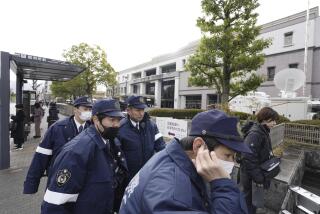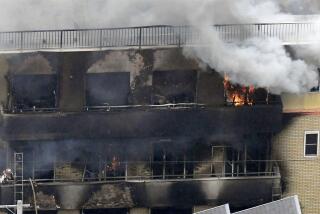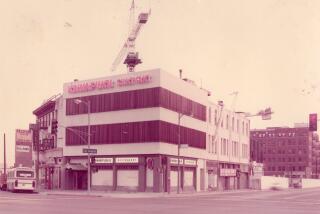Blaze Kills 44 in Tokyo Adult District
- Share via
TOKYO — A fire in Tokyo’s Kabukicho entertainment and sex-trade district early today killed at least 44 people and badly injured three others in the city’s deadliest blaze since World War II.
The cause of the fire was under investigation, but police and firefighters said it apparently broke out about 1 a.m. in a gambling hall on the third floor of a four-story building. Smoke quickly overwhelmed the estimated 40 clients and employees on the top two floors.
The blaze, on Japan’s annual Disaster Prevention Day, occurred in the middle of one of Tokyo’s most famous pleasure districts, a square-mile area known for centuries for its narrow streets, low-rise buildings and anything-goes sex trade.
The narrow building had no fire escape, sprinklers or emergency exits, according to fire officials. The single staircase reportedly was cluttered with lockers, which hampered the victims’ escape and the rescue operations.
“I saw a man jump off the building and thought it was a suicide. Then I saw smoke pouring out of the building,” a witness told the NHK television network.
“The smoke was so thick and black and smelled strange, not like a normal wood fire,” said another. “Then I heard two or three muted explosions.”
Efforts to identify the 32 men and 12 women were hampered because the bodies were badly charred. Most of the women were teenagers or in their early 20s and were believed to have worked in two of the building’s businesses, Entertainment & Amusement and Super Loose. The building also had two gambling lounges, Paradise Casino, in the basement and Mah-jongg Game Club, on the third floor, where the blaze reportedly started. The men were thought to be customers and workers, most in their 30s, 40s and early 50s.
Television footage of the 650-square-foot fourth-floor business showed relatively little fire damage, suggesting that smoke from the floor below was the main cause of the deaths. Two large couches dominated the main room. Nearby, a smaller room, reportedly used for dressing, was visible, as was one marked “VIP.”
News reports said the building, wedged between a Korean barbecue restaurant and a large billiard hall, passed a fire inspection in 1999, in a neighborhood where police have reportedly long turned a blind eye to the activities of local merchants and their customers.
The neighborhood in the Shinjuku district of the Japanese capital was in the midst of one of its busiest times, as workers headed out to start their weekends.
Nearly 100 firetrucks and ambulances responded to the blaze. Firefighters faced difficulties during the next four hours containing the fire in the narrow, crowded streets.
Giant ladders from two of the biggest trucks extended out over the building amid frustrated efforts to prevent the large loss of life. Below, firefighters in orange suits carried out bodies wrapped in yellow blankets as colleagues held up tarps to shield onlookers from the sight.
A few feet away, paramedics frantically pumped on the chest of a victim. Nearby, a foot in a gray sock could be seen dangling lifelessly from an emergency vehicle.
Victims were taken to 22 hospitals, but most soon died--reportedly from carbon monoxide poisoning related to the acrid, chemical-laced smoke. Three people who jumped from the third floor survived but were in serious condition.
Police said the fire apparently started in a stairway outside the small third-floor mah-jongg betting parlor. An employee sensed something was wrong and reportedly opened the door to the stairway, at which point there was an explosion. Fire officials reported finding a defective gas pipe.
It was unclear how many people were inside the mah-jongg parlor. Some people hurried to the roof and were rescued.
There was early speculation that the building owned by Kurume Kosan Building Rental Co. was defective.
The structure has one small elevator. Automatic fire doors designed to contain flames and smoke reportedly didn’t work, and regulations that require emergency exit routes in any place with more than 10 customers apparently had been ignored.
“This fire does not appear to have started from an explosion. The fire came first,” said Suminao Murakami, professor at the Disaster Prevention Urban Planning Institute. “But there was just no way to escape.”
Prime Minister Junichiro Koizumi extended his condolences to the victims and called for an investigation.
Previously, the deadliest post-World War II fire in Tokyo was a 1982 blaze at the New Japan Hotel, which killed 33 and injured 34. In 1993, a hotel executive was sentenced by Japan’s Supreme Court to three years in prison for violating the fire code.
This morning, a small potted tree without leaves drooped in front of the Kabukicho building’s front door. A series of portable advertisement signs in pink and red were displayed to attract customers: “Sexual Harassment Clinic,” read one, referring to a club for role playing.
According to an article in the Japanese lifestyle magazine Wired, by Tetsuro Onoda, an expert on the Kabukicho district, the area has had a fast and loose reputation for nearly three centuries. In the 1800s, small inns popped up around neighboring Shinjuku station, catering to travelers by providing food, lodging and entertainment.
In 1958, when Japan passed the Prostitution Prevention Law, many predicted that the tough regulations would spell the area’s downfall. Local business owners quickly found loopholes.
In 1985, Japan passed the Entertainment Control Law designed to limit the influence of the yakuza, or Japanese mafia. But gangs continue to skim substantial sums from the area, Onoda says, using shell companies and other indirect means to control the business. In recent years, he added, outright prostitution has declined somewhat even as closely related forms of entertainment have increased.
*
Makiko Inoue in The Times’ Tokyo Bureau contributed to this report.
More to Read
Sign up for Essential California
The most important California stories and recommendations in your inbox every morning.
You may occasionally receive promotional content from the Los Angeles Times.










